
Ashton Class
Survey Vessel
By Bryn Monnery, Laurent Esmiol and D Hebditch
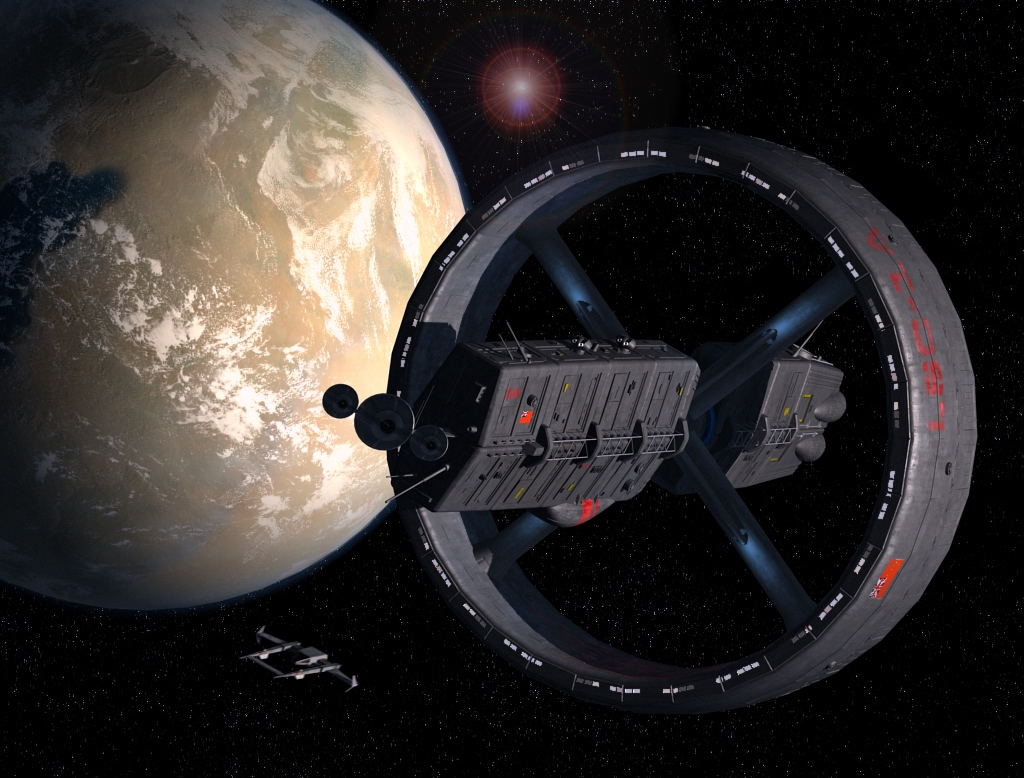
|
Above: The De Lancey on operations in the Henry's Star system above Crater (RJSF Media Ops) Introduction The two Ashton class survey vessels are the centrepiece of the Foundation for Practical Knowledge's plans for the 24th Century. They are deep space capable survey ships that would challenge the likes of the Vogelperspektive and Bayern and free the FPK from its reliance on the Royal Society and possibly even pave the way for Wellon to start its own colonies. However the war on the frontiers of the French Arm have stymied these plans and only the Ashton has been used as an exploration and scientific vessel. Its sister ship, the De Lancey, has been drafted into the war effort and has been used by the Royal Space Navy as a command ship for operations to liberate human colonies from the Kafers. Acknowledgements FSI Roton is by Jonathan Pearson. All pictures in this article are by Laurent Esmiol. Narrative The De Lancey hung above the brown, desolate world known as Crater. Its immensely powerful sensors focused on a small portion of that world's Dayside, whilst its antennas transmitted and received a constant stream of encoded data. In close escort was the small frigate Ariadne which as well as being the big ship's goal-keeper was on task to provide orbital bombardment to the troops on the ground. In the Ops Centre personnel from the Assault Landing Group were collecting and sifting intelligence, relaying information and providing a link for operations on the ground and in space. A little further along the ring in the bridge the mixed civilian and military crew kept the ship well in hand. A motley crew by any standard, they had as much time in the combat zone as any of their more illustrious military counterparts. The De Lancey's hangers and small craft team were kept busy shuttling down vitally needed supplies and evacuating casualties. On the ground itself a highly trained Phantom team from the Royal Space Corps followed the Tac HQ of a Para Battle Group as it advanced through the a canyon towards the Kafer's final stronghold. Up ahead an elite platoon forming the 'Forlorn Hope' was killing sentries and preparing charges to burrow through the first layer of defences. The Phantom team and the rest of the Tac HQ hit the ground as a barrage of heavy ASAT missiles erupted from the ground several kays away. The signaller broke into the rebro stream to deliver a warning, probably redundant, to the orbiting ships. … Nearly 50 light years away the Ashton was entering orbit above Wolverine. It had been over a year since her first visit to the remote planet and its isolated, isolationist colonists. Since then the ship, alongside her Canadian and British companions, had been to the very ends of the Chinese Arm past Doris. Their detailed survey of the systems of the Bridge had proved beyond doubt the concept of the ship. Being able to sustain herself and the crew in-system and on-world for a significant period of time. Now she had returned to her first port of call on her maiden mission. To recover the small team of FPK anthropologists that had been deployed down to Wolverine. The flight crews were already prepping one of the ship's Ravens whilst the operations teams attempted to make contact with the team or the local authorities. However their repeated calls were met with silence and increasing concern. The Captain took the decision and prepared an armed team to go down to the surface. Development |
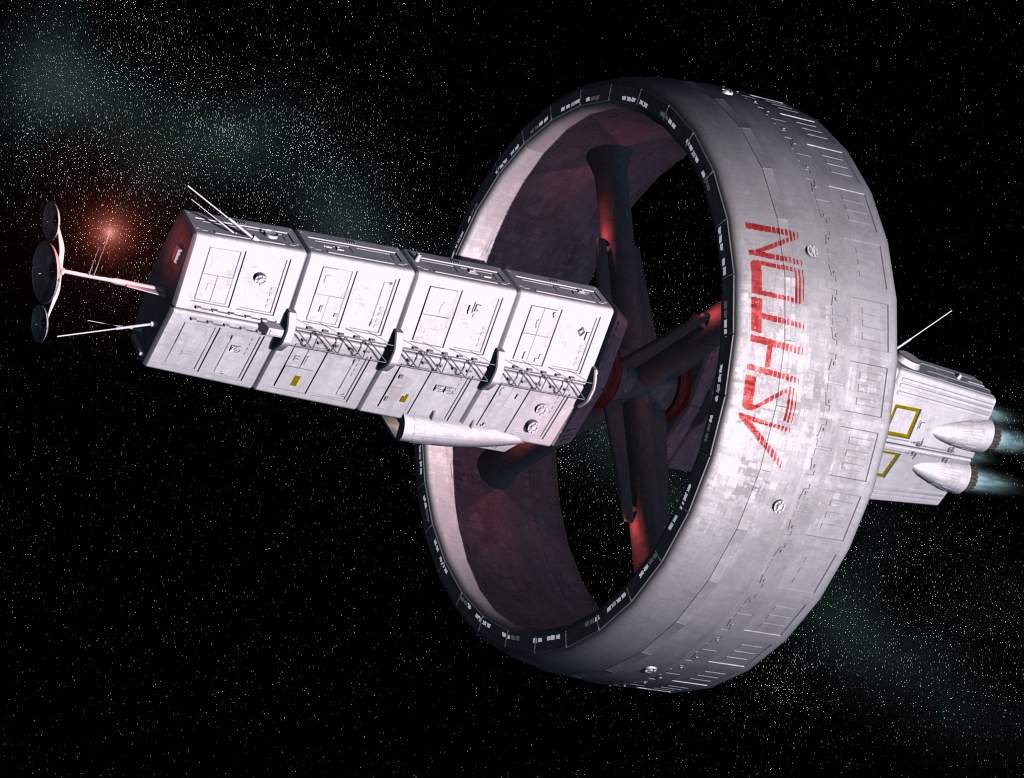
|
Above: The Ashton undertaking her first in-system trials in early 2298. (FPK) The Ashton Class of vessels were the brain child of the then chairman of the Foundation for Practical Knowledge Patrick Chan. He wanted the FPK to take a more active and singular role in space exploration. The FPK, a very wealthy and prestigious Wellonese foundation, was already involved in space exploration but usually ran its operations alongside the Royal Society or with resources of the Royal Space Navy's Astrographic Service. Chan wanted the FPK to start to rival not only the Royal Society but foundations like the ARI, the acknowledged leaders in deep space exploration. Chan and his faction within the FPK wanted ships that could push deep into areas far from the normal run of Anglophone colonies. Whilst the funding to build these ships was available within the FPK, as was the expertise to crew them, the limiting factor was the lack of available Tantalum. The solution appeared through unofficial conversations between senior RSN officers and FPK officials. If the FPK was willing to build their ships to be capable of acting as auxiliary troopships which could be mobilised by the RSN in wartime then the RSN would see to it that the FPK could have access to Britain's tantalum stocks. This deal was discussed thoroughly within the FPK's Council of Fellows and was a matter of no little controversy, not just for the huge monetary outlay. The FPK had long and excellent relations with the RSN's Astrographic Service, however the anti-militarists within the FPK did not want the possibility of one of their ships being on one side or another of a conflict. In the end Chan and his faction won out and the ships were laid down in the British Ludlum yards in Hawking Station above Tirane. They were designed by the Victoria based Infinity Design Group. The key characteristics of the design were to be sustainability, robustness and speed. It was envisioned that the Ashtons would be deployed at the far ends of the frontiers and would need to have minimal transit times as well as the ability to stay on station for a substantial duration whilst undertaking their survey and exploration missions. Similarly as well as their possible auxiliary transport missions they would also need to operate in areas that might not be secure, the threat of piracy on the Chinese Arm being especially worrying. The ships would be outfitted to conduct a whole range of scientific missions; from initial survey to detailed exploration and including dedicated investigative missions. Consequently the ship was equipped with an impressive array of labs and sensors. The need for a multiply redundant interface capability was incorporated into the design with a combination of landers, rotons and spaceplanes being carried by the vessel. The Ashtons were designed with some sumptuous accommodation, rivalling that found on the expensive of liners. This decision was partly for reasons of prestige, partly to ease the hardships of serving on such ships for long duration missions but also to enable the ship's compliment to be rapidly expanded in times of need. In particular in their secondary military troopship role. The construction of the Ashtons was a matter of great interest on Wellon, with almost ubiquitous media attention especially through the FPK owned media outlets. The Ashton was the first ship to be completed in 2298 and was launched by the Governor General of Wellon, the Princess of Wales - the future Queen Margaret. |
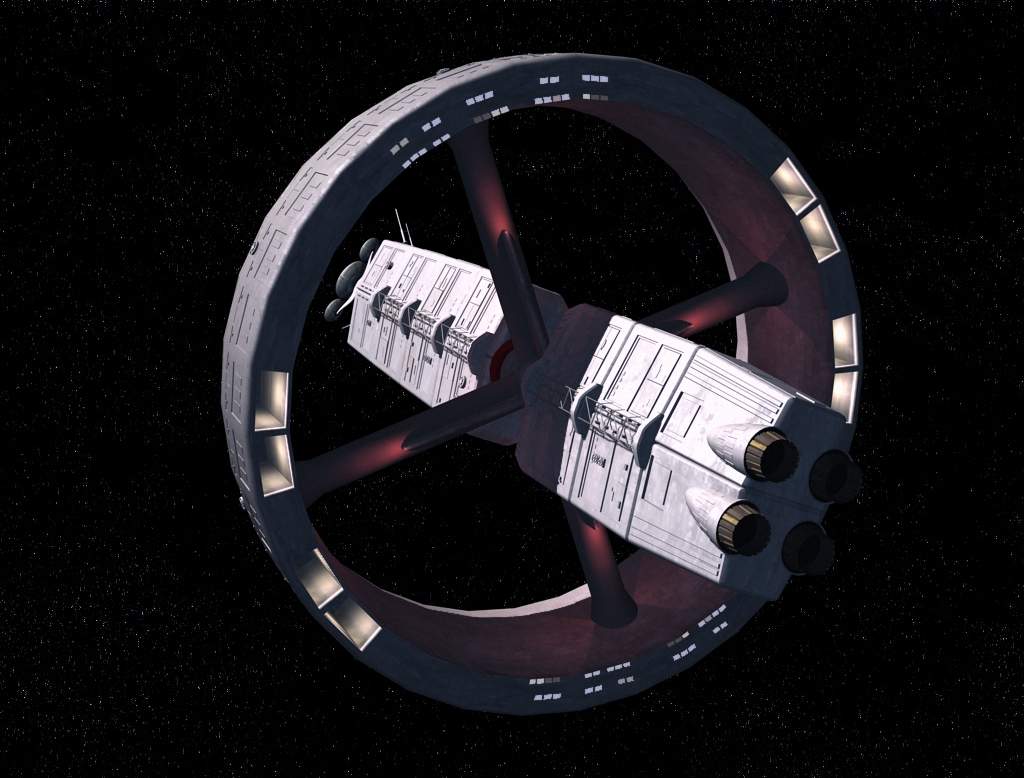
| Above: The Ashton again on trials
in 2298. Note the unfinsihed hangers in the main spin habitat. (FPK)
The Ashtons have a simple configuration of a main hull and a large spin habitat. The main hull is a tall, relatively thin design which has numerous decks within it, all under zero-G. This part of the hull is home to the engineering sections and the ship's engines and stutterwarp. Either side of the habitat are the spin and de-spin machinery which maintain the rotation of the habitat. Forward of the habitat the hull contains the remainder of the avionics, computers, zero-G scientific facilities, fuel tanks, holds, the reserve bridge and the hanger used to contain the ship's flotilla of drones, satellites, remote craft and zero-G cargo movers. The habitat is a large ring which is divided into four key sections. There are two interface operations complexes which both include four large hangers, flight operations and maintenance facilities. One of the remaining sections includes the ship's quarters, recreational and messing areas. The Ashton has extremely plush accommodation and is a comfortable place in which to live and work. The remaining section includes the bridge, operations centre, labs and work stations and is where the bulk of the work on-board ship is conducted. The De Lancey shares the same configuration as the Ashton in most respects. However the ship has been fitted with a number of weapon systems for self-defence purposes. In addition the labs and workstations have been refitted with more accommodation while the existing quarters have been converted to a much more spartan configuration. This allows the ship to carry many more soldiers on board. The crew complement of the Ashtons remains the same as the original plans for the class. In practise the crew are divided into four sections each with a specialisation vital to the ship and its operations. Crew Division The Crew Division, or C-Div, is responsible for the routine operations involved in piloting and maintaining the ship. The C-Div is headed by the Captain who has ultimate control of the ship. It also includes the bridge, engineering and the bulk of the operations sections of the crew. The C-Div is broken down with 24 personnel assigned to the bridge, nominally in two shifts but more frequently in four shifts for routine operations. There are 10 operations crew who work in two shifts. Finally there are 21 engineering crew, including the Chief Engineer and two 10 man shifts. In most routine operations the work patterns are fairly flexible. This is aided by the ship's highly capable Black Arrow central computer, said by some to be more advanced than the Aristotle of the Bayern. C-Div is composed of a rather mixed bunch. Many are ex-military but some have come from a merchant background and others have great experience in the service of a range of foundations. The crew of the Ashton were hand-picked for the mission and many are veterans of numerous missions to the edges of human space. Interface Division The ship's Interface Division is responsible not only for the operation and maintenance of the ship's landers and spaceplanes but also man the small zero-G cargo movers and maintain the ship's other unmanned small craft. The Ashton has 15 personnel in its I-Div although some of the engineering personnel of C-Div are also involved in the maintenance of the equipment. The Ashton's I-Div are also a rather eclectic group. Initially the bulk of the pilots were drawn from former RWAF interface pilots. However the escalation of the Kafer War meant that several of these were recalled to service and were unable to fulfil their contracts. Instead a number of Canadian and some Azanian pilots were employed. Scientific Division The Sci-Div is the raison d'être of the ship. It comprises the scientific and analysis teams which conduct the investigation tasks the ship undertakes. These are organised under the command of the Chief Science Officer who ranks alongside the Captain in the conduct of the mission. The Ashton routinely carries 60 Sci-Div personnel. The actual composition of this team depends on the mission and the individuals' disciplines are tailored to its success. Each member of the Sci-Div has their own workstations and lab space in the main ring. Support Division The S-Div contains those crew members who are responsible for the support and upkeep of the rest of the crew. These include 5 medical and 15 steward personnel. It should be noted that 10 of the assigned stewards are also military trained personnel who have duel responsibility for protecting the ship from boarding or at station and would form any ground party. Some of these personnel also act as loadmasters for I-Div landers. On the Ashton these are mostly ex RWAF Air Commandos and former 'Red' Royal Marines, needless to say standards of food service are somewhat mixed.. De Lancey The crew organisation of the De Lancey is somewhat different as there is no embarked Sci-Div complement. Several RSNR and a few RSN personnel were drafted into the ship when it passed into military control. The bulk of the crew also nominally enlisted in the RSNR, or in some cases RCSN or USSF, however there are several hold-outs who retain their civilian status. The spartan ship has room for an additional 800 soldiers and an enhanced interface capability from A and B Flights of 1202 Naval Interface Squadron. The De Lancey is usually the home of the ASLAN Tactical HQ. It can also embark elements of 6 Assault Brigade, normally the HQ and some brigade combat support units. Alternatively in the conventional trooper role it can embark an infantry battle group. |
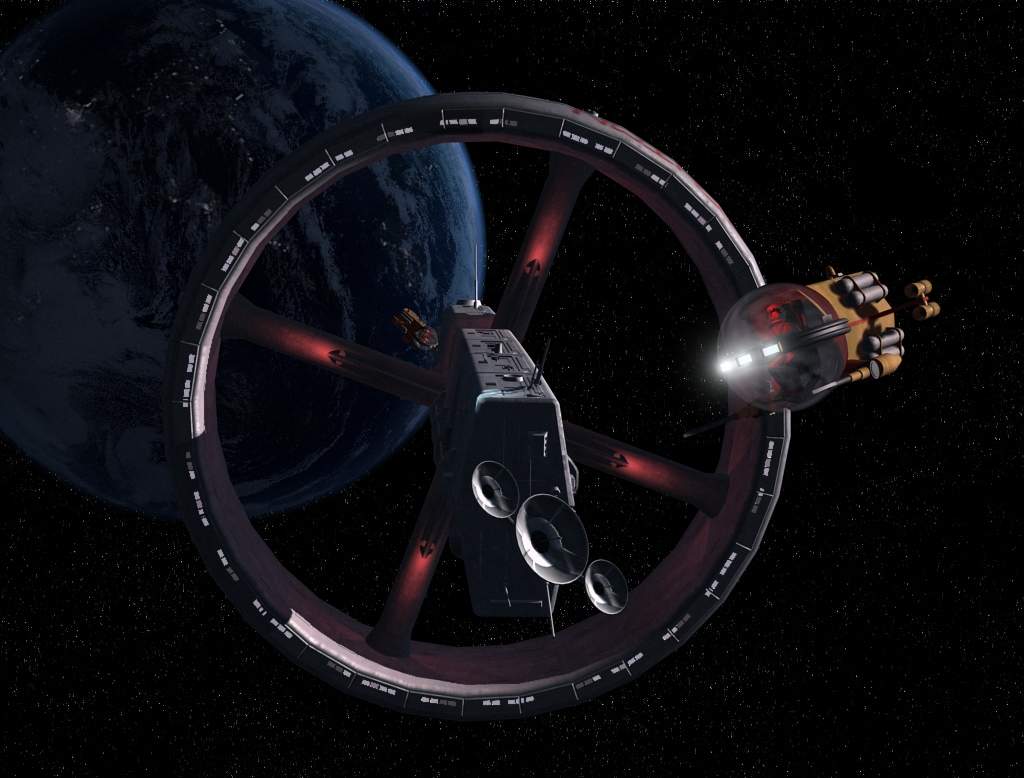
|
Above: The Ashton in orbit around
Doris in 2202 on her return from 'The Bridge'. Note the two CargoMates
in close attendence. (FPK) No. in existence: 2 (Ashton and De Lancey) Date First Hull Commissioned: 2298 Performance: Warp Efficiency:
2.32 (standard load) Move:
5 Sensors: Navigation Weapons None (DeLancy carries 4 Gallowglas, linked to 4 TTAs) Small Craft 4 demilitarised Raven (4/turn), 2 ML-95 Rotons (2/3 turns) and 2 Galaxie (2/3 turns) (DeLancy carries 8 armed Raven and 2 ML-95 and 2 Galaxie) Hull hits: 57 |
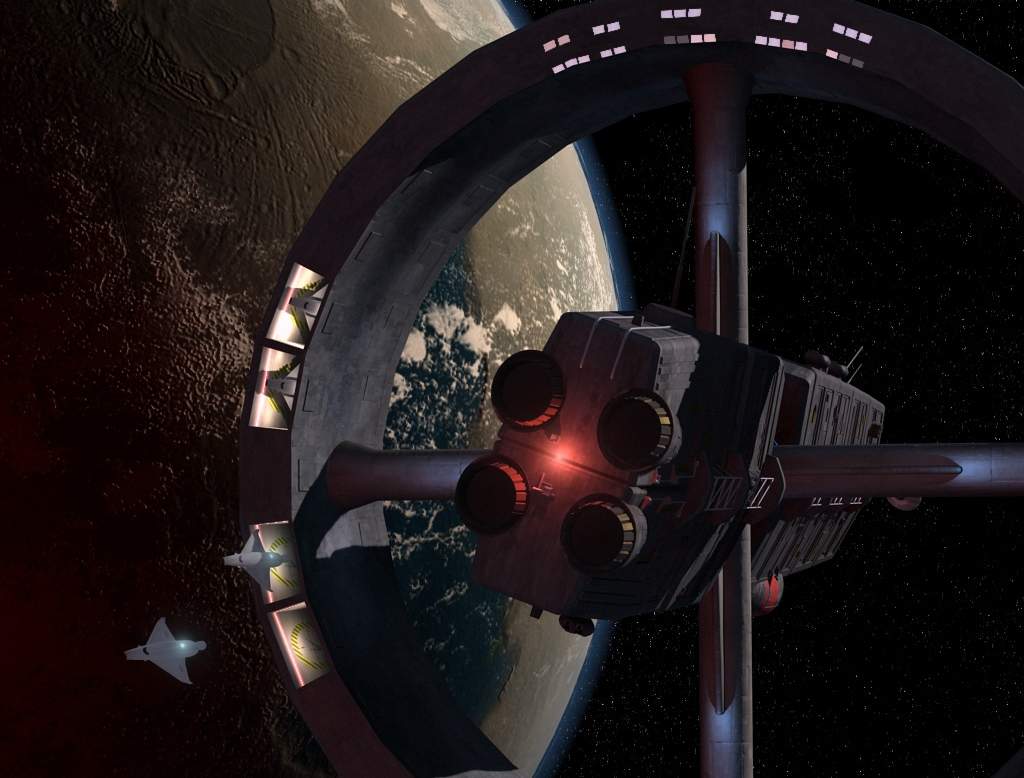
|
Above: The De Lancey on operations above Crater. Note the use of French Tornade II landers and the fully fitted out hangers. (RSJF Media Ops) Ashton The Ashton was launched from Hawking Station in 2298. She was run through an extensive period of trials before being certified for operations. The most lengthy of these procedures was in the development of her interface capability which was conducted from the Royal Wellon Aerospace Forces' Colenso facilities. In 2299 the ship was dispatched on a mission to Queen Alice's Star carrying a routine FPK mission and a documentary crew. At the same time a scientific team was being recruited for a potential mission on the Chinese Arm. The Capricorn Expedition is a joint mission between the Canadian Department of Colonization and Exploration, the FPK and the Royal Society. The mission was to be conducted in phases, first to four stars known as 'The Bridge' and the onto the Capricorn Cluster itself. The FPK saw this as an ideal opportunity to engage in deep scientific operations and showcase its new starship. It took until late 2301 for the mission to be mounted with the Ashton alongside one British and three Canadian vessels from around the Canadian colony of Doris. The Ashton inserted a team of anthropologists onto the world of Wolverine to study the isolationist colonists there as a preliminary operation before moving to the Bridge. The well armed HMS Herald went first, deployed by a tug across the greater than 7.7ly gap to the Bridge. The Ashton was the last to make the jump. However once there it was involved in the survey of three systems, conducting ground landings on three planetary bodies. The Ashton returned to Doris to replenish in mid-2302, the last of the original ships to return. The 1st Phase of the Capricorn Expedition had gone well, and the 2nd Phase move to the Capricorn Cluster proper was being planned for early-2303. The Ashton is commanded by Eleanor Edwards, a Wellonese of American-Tiranian extraction with experience as both a merchant captain and on expeditions with the NARL and FPK. The Chief Science Officer is Dame Sophia Carter another Wellonese with a background of scientific missions on the Chinese Arm. De Lancey The De Lancey came out of the Hawking Station shipyards in 2300, and went through a similar work-up process as the Ashton. However the RSN was taking an close interest in the vessel, especially Captain Keith Williamson RSN, then an officer attached to HMS Dare, the Hawking Station naval base. Williamson was due to take up a posting as Commodore of the Assault Landing Group (ASLAN) as was inspecting much of his potential shipping. The Kafer's destruction of Hochbaden and the assault into the French Arm caused the RSN to step up onto a war footing. As most of the service's troopship capacity was taken up in shuttling army units around the French Arm there was a serious deficient in starlift. As such several large starships were 'STUFT' or mobilised from the merchant fleet and so was the De Lancey. She was rapidly refitted with her plush accommodation being stripped into something entirely more utilitarian and a stronger defensive armament fitted. Additional crew from the Royal Space Naval Reserve were mobilised to bolster her crew and replace those crew who did not wish to serve. Her captain was the flamboyant Captain Sir Alan Gallagher-Fitzroy RSNR, FRS who had managed to combine a career as an explorer and a frigate captain before retiring from the service. The De Lancey saw her first services as a fast transport moving troops and equipment from Queen Alice's Star deeper into the warzone. In fact she was nearly trapped with the Normandy at Beta Canum Venaticorum but Captain Gallagher-Fitzroy took a gamble and successfully ran through the disputed system of Kimanjano to link up with the Reserve Fleet at QAS. It was then that the Terran forces realised that if they managed to stop the Kafer juggernaught, they would have a serious liberation effort on their hands. Commodore Williamson requisition the capable De Lancey to act as his command ship in any forthcoming assaults. It was a role the ship, with its excellent communications and computer systems allied to good speed was perfectly suited for. The Battle of Beowulf did indeed stop the Kafer invasion in its tracks and brought about a human counter-attack down the Arm. Whilst the French were to lead the effort to retake Kimanjano the British were to take the lead in consolidating the human position on BCV. Although the French Admiral Rochemont had grandly declared the planet 'liberated' there was much fighting left to be done. Williamson in the De Lancey co-ordinated the initial wave of British Marines and Paratroopers onto New Africa and then managed the British, German and French heavy follow on forces in their deployment. The ship then finally landed the headquarters of the II British Corps which took over command of the ground forces. The landings proved remarkably smooth and successful. Soon after this the De Lancey led the 2nd Assault Flotilla to reinforce the world of Crater where fighting was continuing. The ship would remain in orbit throughout the 3 month Dayside Campaign that brought about an end to the major Kafer presence on that world. Towards the end of the campaign the De Lancey and her goalkeeper HMS Ariadne were engaged by Kafer ground based ASAT resources which resulted in Ariadne taking serious damage. The De Lancey then returned to BCV and took part in a number of operations, including co-ordinating British relief efforts to Nous Voila and the British colonies. The ship has yet to be returned to the FPK and looks likely to remain a key element of the fleet for some time to come. |
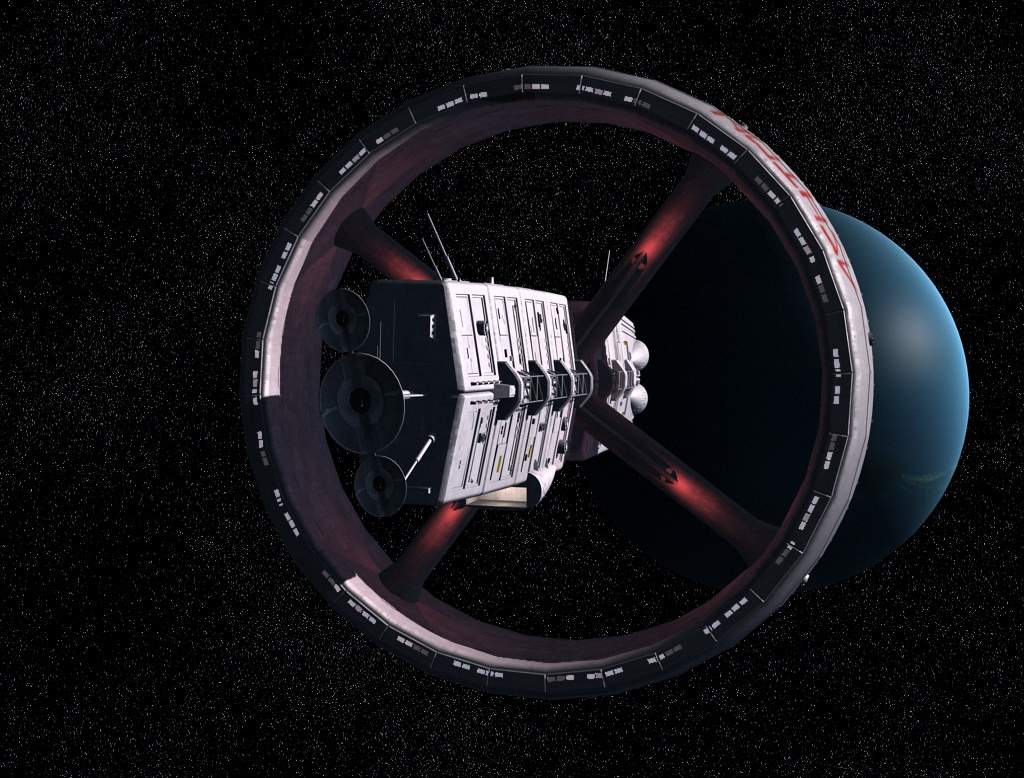
|
Above: The Ashton departing Doris in 2301 en-route for Woverine and then 'The Bridge'. Note the hanger for satellites and CargoMates under the forward hull. (FPK) The Ashton has an impressive interface capability. This includes four Raven VTOL aerodyne landers, two medium sized rotons and two large spaceplanes. The rotons provide effective heavy lift capability, the Ravens a robust, rough strip and rapid landing capability and the Galaxie spaceplanes the capability to move large loads and land at prepared sites. The Ashton has a further two zero-G CargoMate units used for movement of cargo or major external repairs. There are also a large number of communications, navigation and mapping satellites. A further two old military style sensor drones are also carried. The Ashton routinely carries a number of Explorer ATV, Reynard ACV and other vehicles to give its teams ground mobility when landed on planetary surfaces. The British Exospace Raven is a design used by the British military of which four demilitarised versions have been acquired by the FPK. It is a VSTOL aircraft and can land virtually anywhere with a reasonably firm surface. It can also be used for movement within the atmosphere and can carry around 20 people and cargo in reasonable levels of comfort. The De Havilland Wellon Hauke is an easily maintained medium roton vehicle. It is a licence built version of the Flame Spiral Industry ML-95 model. This vehicle can land with ease on rough strips with up to 100 tons of cargo or 50 personnel and return to orbit with equal ease. The Hauke however is less versatile at moving within a planetary atmosphere. Two of the hangers have been specially modified to carry the rotons. However they are usually un-docked to load from the forward part of the hull by the CargoMates which is the easiest way of loading them with cargo. The Dassault Galaxie are French built logistic landing space planes. These are large conventional craft which are used when within settled human space and when the ship has access to established facilities. They are a well established, efficient and economical design. |